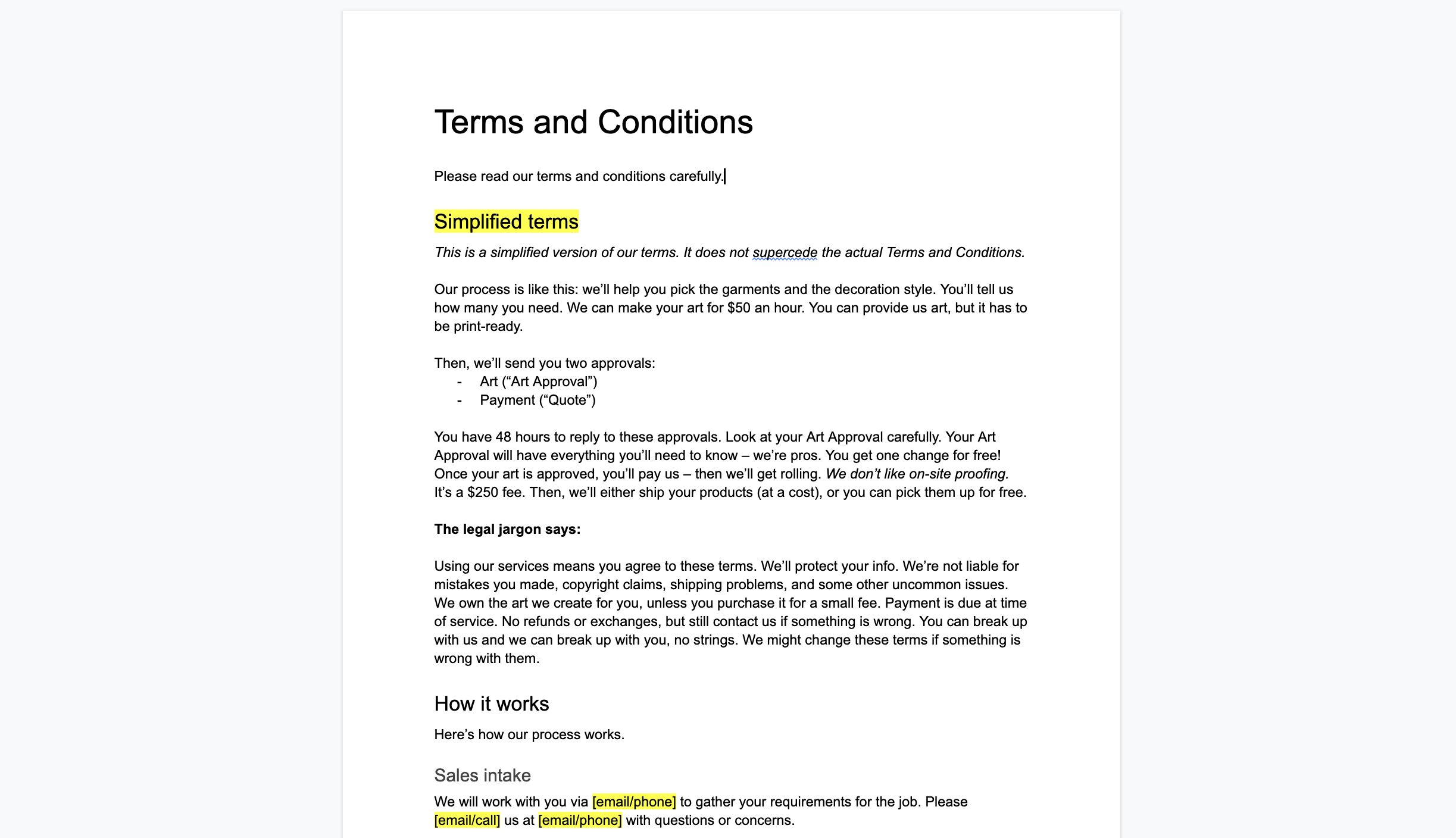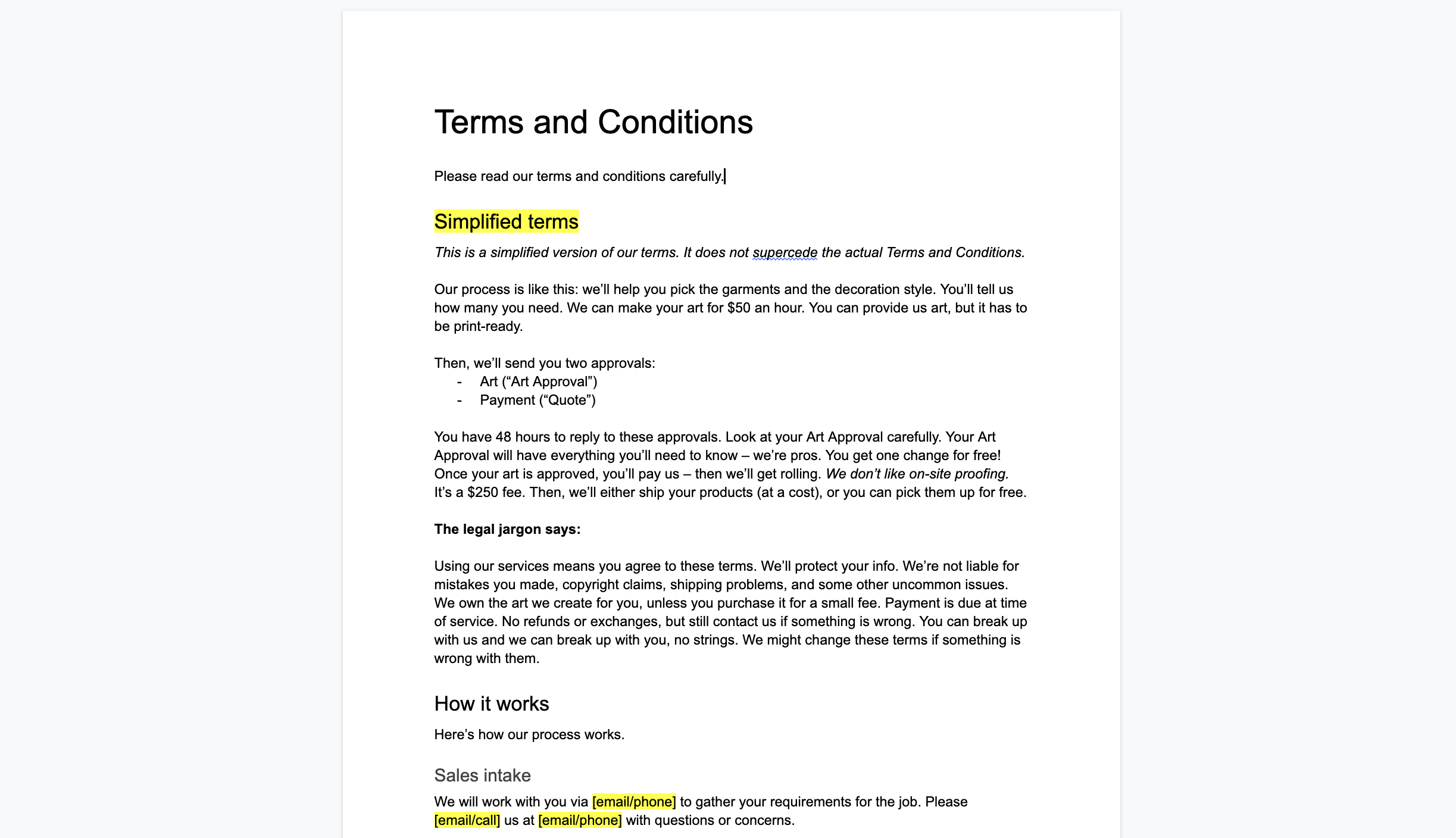Writing Terms and Conditions for your screen printing business is daunting.
You’re a printer, not a lawyer – but you need rock-solid terms of service to prevent problems with your customers. Luckily, we’ll show you how to write your own terms of service and arm you with several examples you can modify for your screen printing shop.
Contents
- Why you need terms and conditions
- 10 things you want in your terms and conditions
- FREE DOWNLOAD: Example terms and conditions
Note: you can enter your own unique Terms and Conditions in Printavo that will appear on each Quote or Invoice. Head to My Account, then head to Invoice Information. Enter your T&C in the box pictured below.
Why do I need Terms and Conditions for my screen printing business?
Terms and Conditions are a powerful tool for any business. While you probably encounter them most often on the websites and apps you use, it’s really essential that any type of business have clear Terms and Conditions.
There are four primary reasons you want to have good Terms and Conditions in your business:
- Terms and Conditions prevent abuse. Not only do Terms and Conditions protect your customers against mistreatment, but they also protect your business against unscrupulous customers that might abuse your services.
- Terms and Conditions set expectations. Well-written Terms and Conditions clearly define expectations for customers: from print locations to delivery dates, your Terms and Conditions define exactly what your customers should experience. They also hold your business accountable.
- Terms and Conditions limit your liability. Most valuably, Terms and Conditions define the exact dimensions of your responsibility to your customer. You can prevent issues with spoilage, returns, refunds, and non-payment
- Terms and Conditions establish ownership of artwork. Not every screen printing business encounters this, but many shops have: a customer goes through your process, has art created, and then has another shop actually print that art. Your Terms and Conditions can prevent this (if applicable).
In other words, the goal of our Terms and Conditions is to prevent customers from abusing your service, limit the liability your company has, set customer expectations for the services they’ll receive, and establish ownership of any property (i.e. artwork) that’s exchanged or created.
10 things you (probably) want in your Terms and conditions
While every screen printing shop is different, there are 10 basic elements that you should consider having in your business’ Terms and conditions.
Item #1: General service terms and ground rules
This is a chance to explain your entire process for the customer.
You can include specifics that involve when you’ll communicate, how you’ll exchange information, and most importantly what you will and will not do for the customer.
In this section, take the time to fully explain to your customer what it is you do and how you will do it for them. An easy way to achieve this is to look at your Printavo statuses (or your shop’s workflow chart) and look for parts of your process where your customer is involved. This typically includes:
- Sales intake
- Defining job specifications
- Quoting
- Quote approval
- Art approval
- Art revisions
- Press proofs and approvals
- Shipping or pick-up
- Spoilage and misprints
- Rejections
- Refunds and returns
Your first section should be very similar to your internal policies and procedures, but in language that a customer understands. Don’t use technical jargon or screen printing industry language – stick to what the customer should know if any problems arise.
Why this works: when the inevitable misprint, challenging customer, or late shipment happens, you can refer to your Terms and conditions as a roadmap for resolving the issue. If challenged by a customer or confronted over an issue, you can use the Terms and conditions to backstop your argument.
As a rule, remember that it’s often better to smooth things over with good customers instead of sticking to your guns – even if it costs you a little bit of money in the short term. Consider the lifetime customer value of that client. If it’s someone that only orders once a year, maybe it’s worth sticking to your guns. If it’s a local business that orders multiple times a year, perhaps you should simply re-print the job and make them happy.
Item #2: An acceptance clause
Your Terms and conditions are no good if they’re not easily accessible and accepted by your customer. To make it accessible, put it in a prominent place on your website. You should also be certain to put it in your Printavo Terms and conditions so it’s displayed for your customers on Quotes and Invoices. We even suggest putting a link to it in your email signature.
Most acceptance clauses now are based on continued use of the service as acceptance of the Terms and conditions. This typically means including the phrase “Use of our services constitutes acceptance of the Terms and Conditions.” If customers don’t like your Terms, they cannot use your service!
Item #3: Privacy policy
If you’re collecting information about your customers (even just names and email addresses), we suggest implementing some kind of Privacy Policy.
Most experts suggest drafting a separate Privacy Policy and including a simple phrase like: “Our company shall implement and maintain reasonable procedures for protecting personal information in accordance with local law and our Privacy Policy.”
Additionally, be sure to actually implement those procedures.
Item #4: Limitation of liability
Besides your first section that outlines the specifics of your screen printing services, you should also include a robust limitation of liability.
This is a great area to explain that you cannot print copyrighted art or material (the “no bootlegging” clause).
The goal is to clearly demonstrate that your business cannot be held liable for any problems arising from the use of your services. Some ideas for what to include here:
- Problems relating to missed events due to deadlines or shipping errors
- Misprints
- Spoilage
- Late orders
- Breach of contract
Note: if you’re concerned about liability and don’t already have robust insurance to protect your business, please consult with a lawyer about this section.
Item #5: Property rights
While this is typically used to protect web companies against theft (i.e. their logos, content, images, etc.) – some screen printing businesses use this section to protect their intellectual property: artwork. If you have an art department and spend a lot of time on customer art, it may be worth considering whether your business “owns” the art.
Why you’d want to own the art you make for screen printing: we’ve heard from shops that some customers will essentially “steal” artwork.
They’ll have a print shop make mockups or otherwise craft custom art, then take that artwork to another screen printer to have it printed. If this is a scenario that could harm your business (or if you’ve encountered this before), you can use this section to explain that your business owns any artwork it creates for the customer. You can offer to sell the artwork to the customer.
Alternatively, you can grant ownership of the artwork to the customer in this section if you choose.
Ultimately, you want to define exactly who owns the art your shop makes in this section. While art theft is a rare occurrence, it’s still important to protect your business against it.
Item #6: Payment terms
Here’s another crucial element for your Terms and conditions: your payment terms.
We suggest implementing a 100% up-front payment policy. But we know that isn’t always feasible. In that case, you want to explain the exact details of any terms you offer, or how much a customer should expect to pay as a downpayment before printing.
You don’t need to include specific payment amounts in this section since your business works by individual quoting. However, you may want to outline the nuts-and-bolts details around payment:
- How to pay
- What forms of payment are accepted
- Payment deadlines
- Non-payment policy
- Refunds and returns policy
- Common fees or charges
Your payment terms are also where you can outline your refund and return policy. Generally, screen printing shops can’t offer returns or refunds because they have low margins and print custom-made products that aren’t resellable.
If you are willing to re-print orders under certain circumstances or refund a portion of payment, you can explain that here.
Item #7: Termination clause
While most screen printing shops don’t encounter this issue, you may want to include a clause that explains how you may terminate service at any time. While we don’t see a huge need for this clause for most shops, it can still be useful to cover yourself in case you need to “fire” a bad client or discontinue service for any reason.
A termination clause typically includes language like this: “You are free to stop using our services at any time. We may terminate service, with notice, if you violate our terms, abuse our services, cause us legal liability, or otherwise harm or hamper our continued operations.”
Item #8: Revisions and changes
Over time, you may need to make small changes to your Terms and conditions as you discover new situations that your terms need to address. Typically, businesses start with a broad Terms and conditions agreement and then add specific details as they discover areas they missed or issues the terms haven’t adequately explained.
Because of this, it’s important to include a clause to notify customers that you may make changes to the Terms and conditions. This typically reads something like, “We may revise our Terms and conditions from time to time to better meet legal requirements or address changes in our services. You will be notified via email of any changes to these terms.”
Omitting this may leave you open to legal challenges if customers have not been notified that your Terms and Conditions can change.
Item #9: Contact info
An often-overlooked element of Terms and conditions is contact info. Customers may have questions about your Terms and conditions, so provide them with (at minimum) an email address they can contact to discuss concerns.
Item #10: Simplified terms
Terms and conditions are often written in very specific (and possibly confusing) language, particularly when they’re drafted by a lawyer or legal service. You can make your terms super simple to understand by adding summaries and plain-English explanations of what’s in them.
Pinterest’s terms and conditions are a great example of using simple language to summarize your terms. They even use a different font color to distinguish the summaries. This has helped Pinterest dodge controversy about their terms and conditions relating to who “owns” content posted on Pinterest (for the record: you own what you post on Pinterest, just like you own everything you route through Printavo).
Download: Example Terms and Conditions
Download our sample Terms and Conditions below.




0 Comments